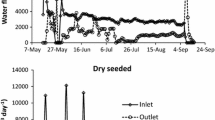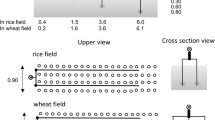Summary
Accurate estimation of crop evaporation from a range of soil types is fundamental to the continued improvement of irrigation management. In this experiment soybean crop evaporation was measured using two weighing lysimeters, one with an undisturbed block of Hanwood loam (L1), the other with undisturbed Mundiwa clay loam (L2). Although both soils have clay profiles the Hanwood loam was much more freely draining. A fresh water-table (EC = 0.01 S m-1) was maintained 1 m below the soil surface of each lysimeter after 18 days from sowing (DFS). The crop (var. Chaffey) was sown on 18 November 1985 both in and around the lysimeters and was harvested 136 days later. Early crop growth was slower in L2 but growth stages after 60 DFS were similar to L1. Estimated leaf area indices exceeded 3 about 51 and 56 DFS for L1 and L2 respectively and were both greater than 9 at 90 DFS. The crop was well watered until at least 110 DFS. However daily rates of evaporation (E) from L1 noticeably exceeded those of L2 beginning around 50 DFS and increased to 30% greater for the period 70 to 115 DFS. This difference was not due to incorrect calibration. Plant water status measurements were generally similar although covered leaf water potential and foliage temperature values indicated that plants on L1 were less well hydrated than on L2. The causes of the E difference are not known, but it was observed that plants in L2 were about 0.1 m shorter than the surrounding plants which were similar in stature to those in L1. It was speculated that this difference in height created a shelter effect which reduced the net radiant energy absorbed by the canopy at low sun angles and reduced the wind speed controlling the turbulent exchange of water vapour. This study highlights the lack of under-standing that exists about the effect that small discontinuities in crop height can have on the spatial variability of evaporation within crops.
Similar content being viewed by others
References
Bland WL, Dugas WA (1988) Converting minirhizotron observations to root length density. Agron J 80:271
Butler BE (1979) A Soil Survey of the Horticultural Soils in the Murrumbidgee Irrigation Area of New South Wales. CSIRO Aust. Bull. No. 289
Dijk DC van (1961) Soils of the southern portion of the Murrumbidgee irrigation areas. Soils Land Use Series No 40, CSIRO, Aust, pp 44
Doorenbos J, Pruitt WO (1977) Guidelines for predicting crop water requirements. FAO Irrig Drain Paper No 24 (revised). FAO, Rome
Dugas WA, Meyer WS, Barrs HD, Fleetwood RJ (1990) Soil type effects on soybean crop water use in weighing lysimeters. II. Root growth, soil water extraction, and water table contributions. Irrig Sci 11:77–81
Fehr WR, Caviness CE, Burmood DT, Pennington JS (1971) Stage of development descriptions for soybeans, Glycine max (L) Merill. Crop Sci 11:929
King KM, Tanner CB, Suomi VE (1956) A floating lysimeter and its evaporation recorder. Trans Am Geophys Union 37:738
Lawson TL, Alluri K (1980) Maximum water requirement of upland rice variety OS6 in the humid/subhumid zone of West Africa. In: Proceedings of a Symposium on the Agrometeorol of the Rice Crop, The Intern Rice Res Inst Laguna Philippines, pp 181–185
Loveday J, Greacen EL, Forrest J, Beatty HJ (1984) Soil Data from a Preliminary Sampling of the Whitton common experimental site, NSW. Technical Memorandum No 16, CSIRO Division of Soils, Glen Osmond, SA
McIlroy IC, Sumner CJ (1961) A sensitive high-capacity balance for continuous automatic weighing in the field. J Agric Eng Res 6:252
McNaughton KG, Clothier BE, Kerr JP (1979) Evaporation from land surfaces. In: Murray CL, Ackroyd P (eds.) Physical hydrology New Zealand experience. NZ Hydrol Soc (Inc) Wellington North, pp 97–119
Melhuish FM, Lang ARG (1968) Quantitative studies of roots in soil. I. Length and diameters of cotton roots in a clayloam soil by analysis of surface-ground blocks of resin-impregnated soil. Soil Sci 106:16
Meyer WS, Barrs HD (1985) Non-destructive measurement of wheat roots in large undisturbed and repacked clay soil cores. Plant Soil 85:237
Meyer WS, Reicosky DC (1985) Enclosing leaves for water potential measurement and its effect on interpreting soil-induced water stress. Agric For Meteorol 35:187
Meyer WS, Dunin FX, Smith RCG, Shell GSG, White NS (1987) Characterizing water use by irrigated wheat at Griffith, New South Wales. Aust J Soil Res 25:449
Muirhead WA, White RJG (1981) The influence of soil water potential on the flowering pattern, pod set and yield of snap beans (Phaseolus vulgaris L). Irrig Sci 3:45
Northcote KH (1981) Morphology, distribution and classification. In: Oades JM, Lewis DG, Norrish K (eds.) Red-brown earths of Australia. Waite Agric Res Instit and CSIRO Div of Soils Adelaide, SA, pp 11–28
Penman HL (1948) Natural evaporation for open water, bare soil and grass. Proc R Soc London A193:120
Pruitt WO, Lourence FJ (1985) Experiences in lysimetry for ET and surface drag measurements. Proc Natl Conf Adv Evapotrans Am Soc Agric Eng, Chicago, Illinois, pp 51-69
Ratliff LF, Ritchie JT, Cassel DK (1983) A survey of field-measured limits of soil water availability and related laboratory-measured properties. Soil Sci Soc Am Proc 47:770
Sakamoto CM, Shaw RH (1967) Light distribution in field soybean canopies. Agron J 59:7
Talsma T (1963) The control of saline groundwater. Meded Landbouwhogeschool, Wageningen 63:1
Author information
Authors and Affiliations
Rights and permissions
About this article
Cite this article
Meyer, W.S., Dugas, W.A., Barrs, H.D. et al. Effects of soil type on soybean crop water use in weighing lysimeters. Irrig Sci 11, 69–75 (1990). https://doi.org/10.1007/BF00188442
Received:
Issue Date:
DOI: https://doi.org/10.1007/BF00188442




